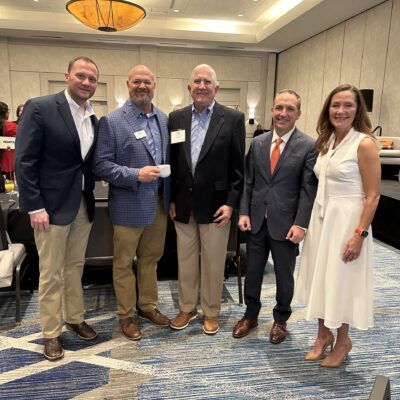
On April 1st, the North Houston Association (NHA) held its much-anticipated Developer’s Breakfast, offering a deep dive into the ongoing challenges and opportunities surrounding affordable housing in Texas. The event featured a panel discussion with experts from various sectors of the real estate and development industries including Mike Fitzgerald, PE, F.SAME of BGE, Inc., Danny Signorelli of Signorelli Company, Becky Ullman of Lennar, Steve Spillette from CDS Community Development Strategies and moderator Daniel Kolkhorst of Howard Hughes Holdings Inc. The panelists shared valuable insights on factors that affect housing affordability, the
impact of local regulations, and the role of public-private partnerships in fostering a more affordable housing market.
The discussion began with a fundamental question: What does “affordability” really mean in the context of Texas housing? Steve Spillette, Director of Research Strategy at CDS Community Development Strategies, explained that the federal standard for affordable housing costs is 30% of a household’s gross income. This benchmark serves as a guide to determine what households can afford to pay for housing. However, Spillette noted that cultural expectations and the unique dynamics of Texas — often referred to as the “Texas miracle” — make affordability a subjective and ever-changing concept.
Danny Signorelli, CEO of Signorelli Company, added that Texas’ affordability has been shrinking over the past decade. Homeownership has become 50% less affordable, putting immense pressure on residents trying to navigate the housing market, making the Texas Miracle much harder to achieve. Several key factors contribute to the rise in housing costs, according to the panelists. Becky Ullman, Director of Board Planning for Lennard Development Corporation, identified three primary contributors to affordability challenges: lot size, material costs, and labor shortages. Signorelli also argued that these regulations often create economic barriers, driving up costs unnecessarily and stressed that quality development should be the focus, rather than size restrictions that limit housing availability.
Ullman provided examples of smaller lot developments that they’re seeing success with in Tavola, that demonstrate how compact housing can still meet consumer demands, especially when coupled with efficient materials and construction practices. Spillette also noted that consumer surveys indicate many buyers are open to living in smaller homes if it means achieving homeownership.
Mike Fitzgerald, Managing Director of BGE’s land development department, shed light on the impact of phasing in development projects. Phasing, where development is divided into stages, helps manage costs by spreading out the financial burden over time. This strategy can be especially beneficial when managing cash flow during larger projects. Fitzgerald shared his concerns about the increasing length of review times for development projects, noting that delays can significantly increase costs and hinder timely delivery of housing. Signorelli also warned that infrastructure costs, such as those related to water and sewer plants, still remain high and often require significant upfront investment emphasizing that public-private partnerships are crucial for addressing Texas’ housing challenges.
One of the more nuanced discussions focused on the role of Homeowners Associations (HOAs) and Municipal Utility Districts (MUDs) in maintaining the quality of life in communities. While these entities are often associated with additional fees and regulations, Ullman pointed out that they are essential for maintaining community standards, from parks to street maintenance. Spillette also raised concerns about the future of MUD bonds, noting that potential reductions in tax exemptions for these bonds could make financing more difficult for developers, ultimately affecting the cost of new developments.
As Texas continues to experience rapid growth, the need for innovative solutions to affordable housing challenges is more urgent than ever. By addressing these issues head-on, the industry can help ensure that future generations of Texans have access to quality, affordable homes.


























